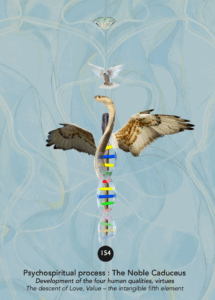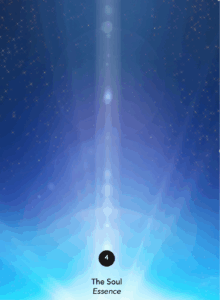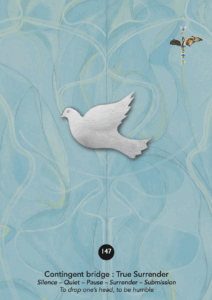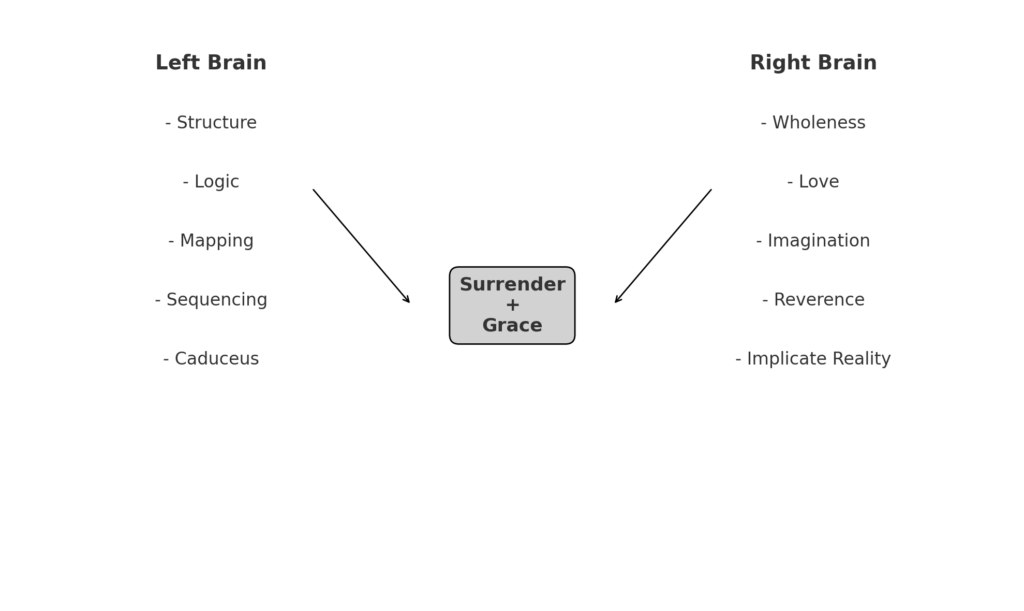Psychospiritual Tools
The Vessel and the Work of Love
Across time and tradition, many cultures have offered symbolic tools—virtues, practices, and archetypes—to aid in the growth of the human being. These help us, like Aladdin with his lamp, to polish the vessel—the body, which we both inherit and grow into. This vessel is not merely a physical form; it is the container of the soul, the place where life is known, refined, and remembered.

In Western thought, the ancient emblem of the Caduceus came to symbolise this journey of inner maturation. What began as a mythic symbol has, over time, become a map of human development: from child to adult, from outer life to inner being, from fragmentation to coherence. The Caduceus encodes the principles and qualities that support our becoming—elements we must acquire, embody, and balance.

In the Islamic world, particularly through the influence of Sufi mysticism, a parallel understanding emerged—one deeply influenced by earlier Chinese thought. The human being, they observed, unfolds through the growth of Love. This was not mere sentiment, but a sacred force—a Divine manifestation seeking to flow through the human vessel. And for this to occur, the vessel must be prepared.
To assist this inner flowering, the Sufis turned to the classical elements—earth, water, air, fire, and ether—as a symbolic map of Love’s nature. Each element represented a quality of Love as it matures within a human:
- Earth – grounding, responsibility, constancy, solid, unwavering, dependable
- Water – mercy, softness, receptivity, purity, clean
- Air – clarity, intelligence, spaciousness, light, easy, untouched
- Fire – passion, purification, will, light bearer, banishes the shadows
- Ether – subtlety, unity, the presence of the unseen, Divine Love
This path is one of self-actualisation—a conscious ripening of the inner life. It is not enough to hope for Love or to receive it passively. The Sufis taught that a reciprocal effort is required: the human must also refine themselves, especially in the realm of Love. This involves purification of the heart, dissolving inner distortions, and aligning the self with something far greater. Only then can the Divine Love move freely through the human form.

Thus, the growth of the soul is not automatic—it is a work, the polishing of the Self. And through this work, the vessel becomes clean, pure and luminous. It is then that the soul is fully present and guides our lives.

Surrender and the Two Brains – A Path to Grace
Within both the InnerDialogue and Human Template processes, the journey ultimately brings us to one essential gesture: surrender. This surrender is not defeat but devotion. It is the quiet bowing of the head, the softening of the will, the humble letting go of what no longer serves. In this openness—this deliberate emptiness—Grace may enter. And when it does, it nourishes, illuminates, and gently steers the course of our becoming.
The two complementary sets of qualities that emerge through this work are not abstract ideals—they are both practical and neurological. They shape how we live, how we think, and how we relate to life itself.
Our left brain, the architect of structure and sequence, maps our worldview and lays out the stepping-stones of our path. It seeks order, logic, and clarity. Here, the Caduceus serves as a vital companion—providing a framework for growth, a symbolic spine around which the developing self can take shape.
Meanwhile, the right brain—that mysterious hemisphere Einstein called our true gift—holds a different task. It is the part of us that senses the whole, that holds ambiguity without fear, that intuits beauty and breathes spaciousness into our tightly managed lives. It does not build the path; it reveals the wider landscape.
This right hemisphere is where Love resides—not as an emotion, but as a capacity. It is the part of us that can hold, polish, and offer Love freely: to ourselves, to others, and to what physicist David Bohm called the Implicate Reality—the deeper order from which all things unfold.
Together, these two aspects—order and spaciousness, reason and reverence—form the full arc of our humanity. The work is to let them meet, and in that meeting, to become whole.
